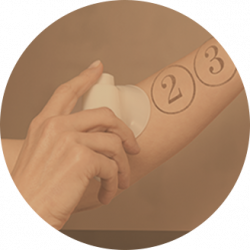

Types of HRT and application
Types of the therapy include taking SERM (short for selective estrogen receptor modulator) medication, taking both estrogen and progestogens (combined HRT) or just taking estrogen (estrogen-only HRT). In every case, a gynaecologist recommends a therapy based on the patient’s individual needs. Most women take combined HRT because taking estrogen on its own can increase the risk of developing womb (endometrial) cancer. Taking progestogen alongside oestrogen counteracts certain mechanisms of how the body reacts to estrogen and minimise this risk. Estrogen-only HRT is usually only recommended for women who have had their womb removed during a hysterectomy.
The type of administration is important, too. The two main different routes of application are oral tablets and transdermal therapy, that are recommended for slightly different symptoms and conditions. Usually transdermal therapy is the first choice for estrogen treatment and it comes in the form of spray, gel or patches. Transdermal methods bear a lower risk for thrombosis even in overweight women, they may lower the risk of stroke, high blood pressure and some forms are the most effective for vaginal dryness and pain during intercourse. On the other hand, oral administration of estrogen increases CRP (C-reactive protein) and triglyceride levels that increase the risk of cardiovascular diseases, as well as SHBG (sex hormone binding globulin) and testosterone levels, possibly leading to loss in libido, while transdermal estrogen does not show these effects.
Hormone pills are available that you have to take orally just as you would do with any other tablet, and this type of administration has especially beneficial effects in cases when the woman has too many male hormones (androgens) in the blood and therefore suffers from increased hair growth. It can be also used to combat weight gain and metabolism issues.
Forms of administration include oral tablets, topically used tablets and gels. Transdermally applicable hormone therapy comes in the form of spray, gel or patches. These methods bear a lower risk for thrombosis even in overweight women, they may lower the risk of stroke, high blood pressure and some forms are the most effective for vaginal dryness and pain during intercourse.
Individual needs is key
For the maximum efficiency and the lowest risk, every woman must decide whether to choose this treatment and if so, the therapy should be selected individually. The hormonal treatment of menopause has greater effectiveness against other therapies, and its positive effects on menopause are highly acclaimed by the International Menopause Society.
This treatment consists of the administration of hormones that the body has stopped producing as a result of the beginning of menopause and combats many notorious symptoms of menopause including hot flashes, vaginal dryness, osteoporosis and, according to some studies, contributes to the cardiovascular health of women.
No two bodies are the same, which means there is no universal therapy for all. As with any other type of therapy, HRT should not be taken without clear indication (the presence of symptoms). If you are thinking of taking HRT then first you should consult your doctor. If you are suffering from the symptoms of menopause then the question is not whether HRT is right for you but rather what form of it. A stress-free, relaxing life can be ahead of you even during menopause, you just have to reach out to a professional for it.

Other interesting and useful articles
Read more articles
in other topics too

Menopause symptoms
Click to read articles about

Manage & living with menopause
Click to read articles about




